Systems development is systematic process which includes phases such as planning, analysis, design, deployment, and maintenance.
example :- Computer System , Business System , Hotel , Library , College.
Audience
This tutorial will help budding software professionals to understand how a system is designed in a systematic and phased manner, starting from requirement analysis to system implementation and maintenance.
Prerequisites
This tutorial is designed for absolute beginners and hence there are no prerequisites as such, however it is assumed that the reader is familiar with the fundamentals of computers.
System Systems development is systematic process which includes phases such as planning, analysis, design, deployment, and maintenance. Here, in this tutorial, we will primarily focus on −
- Systems analysis
- Systems design
Systems Analysis
It is a process of collecting and interpreting facts, identifying the problems, and decomposition of a system into its components.
System analysis is conducted for the purpose of studying a system or its parts in order to identify its objectives. It is a problem solving technique that improves the system and ensures that all the components of the system work efficiently to accomplish their purpose.
Analysis specifies what the system should do.
Systems Design
It is a process of planning a new business system or replacing an existing system by defining its components or modules to satisfy the specific requirements. Before planning, you need to understand the old system thoroughly and determine how computers can best be used in order to operate efficiently.
System Design focuses on how to accomplish the objective of the system.
System Analysis and Design (SAD) mainly focuses on −
- Systems
- Processes
- Technology
What is a System?
The word System is derived from Greek word Systema, which means an organized relationship between any set of components to achieve some common cause or objective.
A system is “an orderly grouping of interdependent components linked together according to a plan to achieve a specific goal.”
Constraints of a System
A system must have three basic constraints −
A system must have some structure and behavior which is designed to achieve a predefined objective.
Interconnectivity and interdependence must exist among the system components.
The objectives of the organization have a higher priority than the objectives of its subsystems.
For example, traffic management system, payroll system, automatic library system, human resources information system.
Properties of a System
A system has the following properties −
Organization
Organization implies structure and order. It is the arrangement of components that helps to achieve objectives.
Interaction
It is defined by the manner in which the components operate with each other.
For example, in an organization, purchasing department must interact with production department and payroll with personnel department.
Interdependence
Interdependence means how the components of a system depend on one another. For proper functioning, the components are coordinated and linked together according to a specified plan. The output of one subsystem is the required by other subsystem as input.
Integration
Integration is concerned with how a system components are connected together. It means that the parts of the system work together within the system even if each part performs a unique function.
Central Objective
The objective of system must be central. It may be real or stated. It is not uncommon for an organization to state an objective and operate to achieve another.
The users must know the main objective of a computer application early in the analysis for a successful design and conversion.
Elements of a System
The following diagram shows the elements of a system −
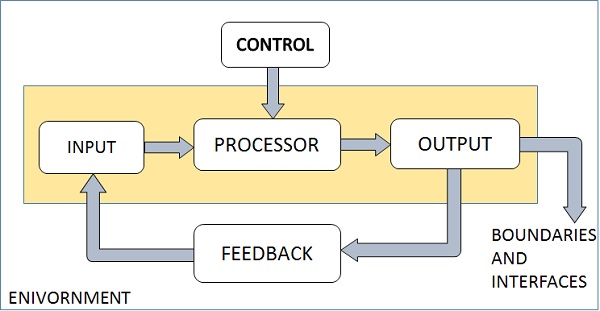
Outputs and Inputs
The main aim of a system is to produce an output which is useful for its user.
Inputs are the information that enters into the system for processing.
Output is the outcome of processing.
Processor(s)
The processor is the element of a system that involves the actual transformation of input into output.
It is the operational component of a system. Processors may modify the input either totally or partially, depending on the output specification.
As the output specifications change, so does the processing. In some cases, input is also modified to enable the processor for handling the transformation.
Control
The control element guides the system.
It is the decision–making subsystem that controls the pattern of activities governing input, processing, and output.
The behavior of a computer System is controlled by the Operating System and software. In order to keep system in balance, what and how much input is needed is determined by Output Specifications.
Feedback
Feedback provides the control in a dynamic system.
Positive feedback is routine in nature that encourages the performance of the system.
Negative feedback is informational in nature that provides the controller with information for action.
Environment
The environment is the “supersystem” within which an organization operates.
It is the source of external elements that strike on the system.
It determines how a system must function. For example, vendors and competitors of organization’s environment, may provide constraints that affect the actual performance of the business.
Boundaries and Interface
A system should be defined by its boundaries. Boundaries are the limits that identify its components, processes, and interrelationship when it interfaces with another system.
Each system has boundaries that determine its sphere of influence and control.
The knowledge of the boundaries of a given system is crucial in determining the nature of its interface with other systems for successful design.
Types of Systems
The systems can be divided into the following types −
Physical or Abstract Systems
Physical systems are tangible entities. We can touch and feel them.
Physical System may be static or dynamic in nature. For example, desks and chairs are the physical parts of computer center which are static. A programmed computer is a dynamic system in which programs, data, and applications can change according to the user's needs.
Abstract systems are non-physical entities or conceptual that may be formulas, representation or model of a real system.
Open or Closed Systems
An open system must interact with its environment. It receives inputs from and delivers outputs to the outside of the system. For example, an information system which must adapt to the changing environmental conditions.
A closed system does not interact with its environment. It is isolated from environmental influences. A completely closed system is rare in reality.
Adaptive and Non Adaptive System
Adaptive System responds to the change in the environment in a way to improve their performance and to survive. For example, human beings, animals.
Non Adaptive System is the system which does not respond to the environment. For example, machines.
Permanent or Temporary System
Permanent System persists for long time. For example, business policies.
Temporary System is made for specified time and after that they are demolished. For example, A DJ system is set up for a program and it is dissembled after the program.
Natural and Manufactured System
Natural systems are created by the nature. For example, Solar system, seasonal system.
Manufactured System is the man-made system. For example, Rockets, dams, trains.
Deterministic or Probabilistic System
Deterministic system operates in a predictable manner and the interaction between system components is known with certainty. For example, two molecules of hydrogen and one molecule of oxygen makes water.
Probabilistic System shows uncertain behavior. The exact output is not known. For example, Weather forecasting, mail delivery.
Social, Human-Machine, Machine System
Social System is made up of people. For example, social clubs, societies.
In Human-Machine System, both human and machines are involved to perform a particular task. For example, Computer programming.
Machine System is where human interference is neglected. All the tasks are performed by the machine. For example, an autonomous robot.
Man–Made Information Systems
It is an interconnected set of information resources to manage data for particular organization, under Direct Management Control (DMC).
This system includes hardware, software, communication, data, and application for producing information according to the need of an organization.
Man-made information systems are divided into three types −
Formal Information System − It is based on the flow of information in the form of memos, instructions, etc., from top level to lower levels of management.
Informal Information System − This is employee based system which solves the day to day work related problems.
Computer Based System − This system is directly dependent on the computer for managing business applications. For example, automatic library system, railway reservation system, banking system, etc.
Systems Models
Schematic Models
A schematic model is a 2-D chart that shows system elements and their linkages.
Different arrows are used to show information flow, material flow, and information feedback.
Flow System Models
A flow system model shows the orderly flow of the material, energy, and information that hold the system together.
Program Evaluation and Review Technique (PERT), for example, is used to abstract a real world system in model form.
Static System Models
They represent one pair of relationships such as activity–time or cost–quantity.
The Gantt chart, for example, gives a static picture of an activity-time relationship.
Dynamic System Models
Business organizations are dynamic systems. A dynamic model approximates the type of organization or application that analysts deal with.
It shows an ongoing, constantly changing status of the system. It consists of −
Inputs that enter the system
The processor through which transformation takes place
The program(s) required for processing
The output(s) that result from processing.
Categories of Information
There are three categories of information related to managerial levels and the decision managers make.
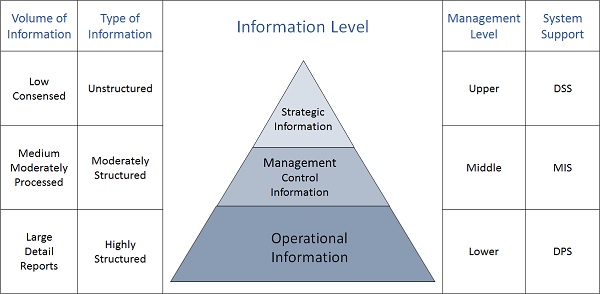
Strategic Information
This information is required by topmost management for long range planning policies for next few years. For example, trends in revenues, financial investment, and human resources, and population growth.
This type of information is achieved with the aid of Decision Support System (DSS).
Managerial Information
This type of Information is required by middle management for short and intermediate range planning which is in terms of months. For example, sales analysis, cash flow projection, and annual financial statements.
It is achieved with the aid of Management Information Systems (MIS).
Operational information
This type of information is required by low management for daily and short term planning to enforce day-to-day operational activities. For example, keeping employee attendance records, overdue purchase orders, and current stocks available.
It is achieved with the aid of Data Processing Systems (DPS).
An effective System Development Life Cycle (SDLC) should result in a high quality system that meets customer expectations, reaches completion within time and cost evaluations, and works effectively and efficiently in the current and planned Information Technology infrastructure.
System Development Life Cycle (SDLC) is a conceptual model which includes policies and procedures for developing or altering systems throughout their life cycles.
SDLC is used by analysts to develop an information system. SDLC includes the following activities −
- requirements
- design
- implementation
- testing
- deployment
- operations
- maintenance
Phases of SDLC
Systems Development Life Cycle is a systematic approach which explicitly breaks down the work into phases that are required to implement either new or modified Information System.
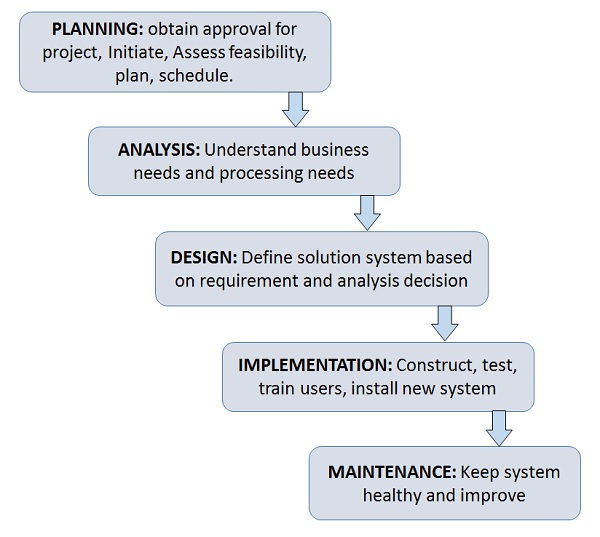
Feasibility Study or Planning
Define the problem and scope of existing system.
Overview the new system and determine its objectives.
Confirm project feasibility and produce the project Schedule.
During this phase, threats, constraints, integration and security of system are also considered.
A feasibility report for the entire project is created at the end of this phase.
Analysis and Specification
Gather, analyze, and validate the information.
Define the requirements and prototypes for new system.
Evaluate the alternatives and prioritize the requirements.
Examine the information needs of end-user and enhances the system goal.
A Software Requirement Specification (SRS) document, which specifies the software, hardware, functional, and network requirements of the system is prepared at the end of this phase.
System Design
Includes the design of application, network, databases, user interfaces, and system interfaces.
Transform the SRS document into logical structure, which contains detailed and complete set of specifications that can be implemented in a programming language.
Create a contingency, training, maintenance, and operation plan.
Review the proposed design. Ensure that the final design must meet the requirements stated in SRS document.
Finally, prepare a design document which will be used during next phases.
Implementation
Implement the design into source code through coding.
Combine all the modules together into training environment that detects errors and defects.
A test report which contains errors is prepared through test plan that includes test related tasks such as test case generation, testing criteria, and resource allocation for testing.
Integrate the information system into its environment and install the new system.
Maintenance/Support
Include all the activities such as phone support or physical on-site support for users that is required once the system is installing.
Implement the changes that software might undergo over a period of time, or implement any new requirements after the software is deployed at the customer location.
It also includes handling the residual errors and resolve any issues that may exist in the system even after the testing phase.
Maintenance and support may be needed for a longer time for large systems and for a short time for smaller systems.
Life Cycle of System Analysis and Design
The following diagram shows the complete life cycle of the system during analysis and design phase.

Role of System Analyst
The system analyst is a person who is thoroughly aware of the system and guides the system development project by giving proper directions. He is an expert having technical and interpersonal skills to carry out development tasks required at each phase.
He pursues to match the objectives of information system with the organization goal.
Main Roles
Defining and understanding the requirement of user through various Fact finding techniques.
Prioritizing the requirements by obtaining user consensus.
Gathering the facts or information and acquires the opinions of users.
Maintains analysis and evaluation to arrive at appropriate system which is more user friendly.
Suggests many flexible alternative solutions, pick the best solution, and quantify cost and benefits.
Draw certain specifications which are easily understood by users and programmer in precise and detailed form.
Implemented the logical design of system which must be modular.
Plan the periodicity for evaluation after it has been used for some time, and modify the system as needed.
Attributes of a Systems Analyst
The following figure shows the attributes a systems analyst should possess −
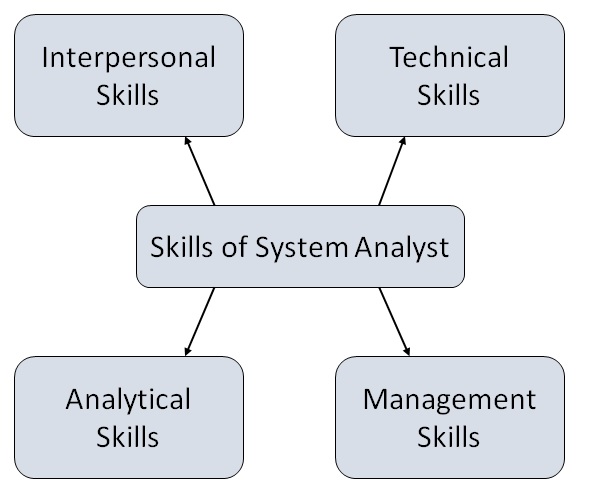
Interpersonal Skills
- Interface with users and programmer.
- Facilitate groups and lead smaller teams.
- Managing expectations.
- Good understanding, communication, selling and teaching abilities.
- Motivator having the confidence to solve queries.
Analytical Skills
- System study and organizational knowledge
- Problem identification, problem analysis, and problem solving
- Sound commonsense
- Ability to access trade-off
- Curiosity to learn about new organization
Management Skills
- Understand users jargon and practices.
- Resource & project management.
- Change & risk management.
- Understand the management functions thoroughly.
Technical Skills
- Knowledge of computers and software.
- Keep abreast of modern development.
- Know of system design tools.
- Breadth knowledge about new technologies.
What is Requirements Determination?
A requirement is a vital feature of a new system which may include processing or capturing of data, controlling the activities of business, producing information and supporting the management.
Requirements determination involves studying the existing system and gathering details to find out what are the requirements, how it works, and where improvements should be made.
Major Activities in requirement Determination
Requirements Anticipation
It predicts the characteristics of system based on previous experience which include certain problems or features and requirements for a new system.
It can lead to analysis of areas that would otherwise go unnoticed by inexperienced analyst. But if shortcuts are taken and bias is introduced in conducting the investigation, then requirement Anticipation can be half-baked.
Requirements Investigation
It is studying the current system and documenting its features for further analysis.
It is at the heart of system analysis where analyst documenting and describing system features using fact-finding techniques, prototyping, and computer assisted tools.
Requirements Specifications
It includes the analysis of data which determine the requirement specification, description of features for new system, and specifying what information requirements will be provided.
It includes analysis of factual data, identification of essential requirements, and selection of Requirement-fulfillment strategies.
Information Gathering Techniques
The main aim of fact finding techniques is to determine the information requirements of an organization used by analysts to prepare a precise SRS understood by user.
Ideal SRS Document should −
- be complete, Unambiguous, and Jargon-free.
- specify operational, tactical, and strategic information requirements.
- solve possible disputes between users and analyst.
- use graphical aids which simplify understanding and design.
There are various information gathering techniques −
Interviewing
Systems analyst collects information from individuals or groups by interviewing. The analyst can be formal, legalistic, play politics, or be informal; as the success of an interview depends on the skill of analyst as interviewer.
It can be done in two ways −
Unstructured Interview − The system analyst conducts question-answer session to acquire basic information of the system.
Structured Interview − It has standard questions which user need to respond in either close (objective) or open (descriptive) format.
Advantages of Interviewing
This method is frequently the best source of gathering qualitative information.
It is useful for them, who do not communicate effectively in writing or who may not have the time to complete questionnaire.
Information can easily be validated and cross checked immediately.
It can handle the complex subjects.
It is easy to discover key problem by seeking opinions.
It bridges the gaps in the areas of misunderstandings and minimizes future problems.
Questionnaires
This method is used by analyst to gather information about various issues of system from large number of persons.
There are two types of questionnaires −
Open-ended Questionnaires − It consists of questions that can be easily and correctly interpreted. They can explore a problem and lead to a specific direction of answer.
Closed-ended Questionnaires − It consists of questions that are used when the systems analyst effectively lists all possible responses, which are mutually exclusive.
Advantages of questionnaires
It is very effective in surveying interests, attitudes, feelings, and beliefs of users which are not co-located.
It is useful in situation to know what proportion of a given group approves or disapproves of a particular feature of the proposed system.
It is useful to determine the overall opinion before giving any specific direction to the system project.
It is more reliable and provides high confidentiality of honest responses.
It is appropriate for electing factual information and for statistical data collection which can be emailed and sent by post.
Review of Records, Procedures, and Forms
Review of existing records, procedures, and forms helps to seek insight into a system which describes the current system capabilities, its operations, or activities.
Advantages
It helps user to gain some knowledge about the organization or operations by themselves before they impose upon others.
It helps in documenting current operations within short span of time as the procedure manuals and forms describe the format and functions of present system.
It can provide a clear understanding about the transactions that are handled in the organization, identifying input for processing, and evaluating performance.
It can help an analyst to understand the system in terms of the operations that must be supported.
It describes the problem, its affected parts, and the proposed solution.
Observation
This is a method of gathering information by noticing and observing the people, events, and objects. The analyst visits the organization to observe the working of current system and understands the requirements of the system.
Advantages
It is a direct method for gleaning information.
It is useful in situation where authenticity of data collected is in question or when complexity of certain aspects of system prevents clear explanation by end-users.
It produces more accurate and reliable data.
It produces all the aspect of documentation that are incomplete and outdated.
Joint Application Development (JAD)
It is a new technique developed by IBM which brings owners, users, analysts, designers, and builders to define and design the system using organized and intensive workshops. JAD trained analyst act as facilitator for workshop who has some specialized skills.
Advantages of JAD
It saves time and cost by replacing months of traditional interviews and follow-up meetings.
It is useful in organizational culture which supports joint problem solving.
Fosters formal relationships among multiple levels of employees.
It can lead to development of design creatively.
It Allows rapid development and improves ownership of information system.
Secondary Research or Background Reading
This method is widely used for information gathering by accessing the gleaned information. It includes any previously gathered information used by the marketer from any internal or external source.
Advantages
It is more openly accessed with the availability of internet.
It provides valuable information with low cost and time.
It act as forerunner to primary research and aligns the focus of primary research.
It is used by the researcher to conclude if the research is worth it as it is available with procedures used and issues in collecting them.
Feasibility Study
Feasibility Study can be considered as preliminary investigation that helps the management to take decision about whether study of system should be feasible for development or not.
It identifies the possibility of improving an existing system, developing a new system, and produce refined estimates for further development of system.
It is used to obtain the outline of the problem and decide whether feasible or appropriate solution exists or not.
The main objective of a feasibility study is to acquire problem scope instead of solving the problem.
The output of a feasibility study is a formal system proposal act as decision document which includes the complete nature and scope of the proposed system.
Steps Involved in Feasibility Analysis
The following steps are to be followed while performing feasibility analysis −
Form a project team and appoint a project leader.
Develop system flowcharts.
Identify the deficiencies of current system and set goals.
Enumerate the alternative solution or potential candidate system to meet goals.
Determine the feasibility of each alternative such as technical feasibility, operational feasibility, etc.
Weight the performance and cost effectiveness of each candidate system.
Rank the other alternatives and select the best candidate system.
Prepare a system proposal of final project directive to management for approval.

Types of Feasibilities
Economic Feasibility
It is evaluating the effectiveness of candidate system by using cost/benefit analysis method.
It demonstrates the net benefit from the candidate system in terms of benefits and costs to the organization.
The main aim of Economic Feasibility Analysis (EFS) is to estimate the economic requirements of candidate system before investments funds are committed to proposal.
It prefers the alternative which will maximize the net worth of organization by earliest and highest return of funds along with lowest level of risk involved in developing the candidate system.
Technical Feasibility
It investigates the technical feasibility of each implementation alternative.
It analyzes and determines whether the solution can be supported by existing technology or not.
The analyst determines whether current technical resources be upgraded or added it that fulfill the new requirements.
It ensures that the candidate system provides appropriate responses to what extent it can support the technical enhancement.
Operational Feasibility
It determines whether the system is operating effectively once it is developed and implemented.
It ensures that the management should support the proposed system and its working feasible in the current organizational environment.
It analyzes whether the users will be affected and they accept the modified or new business methods that affect the possible system benefits.
It also ensures that the computer resources and network architecture of candidate system are workable.
Behavioral Feasibility
It evaluates and estimates the user attitude or behavior towards the development of new system.
It helps in determining if the system requires special effort to educate, retrain, transfer, and changes in employee’s job status on new ways of conducting business.
Schedule Feasibility
It ensures that the project should be completed within given time constraint or schedule.
It also verifies and validates whether the deadlines of project are reasonable or not.Analysts use various tools to understand and describe the information system. One of the ways is using structured analysis.
What is Structured Analysis?
Structured Analysis is a development method that allows the analyst to understand the system and its activities in a logical way.
It is a systematic approach, which uses graphical tools that analyze and refine the objectives of an existing system and develop a new system specification which can be easily understandable by user.
It has following attributes −
It is graphic which specifies the presentation of application.
It divides the processes so that it gives a clear picture of system flow.
It is logical rather than physical i.e., the elements of system do not depend on vendor or hardware.
It is an approach that works from high-level overviews to lower-level details.
Structured Analysis Tools
During Structured Analysis, various tools and techniques are used for system development. They are −
- Data Flow Diagrams
- Data Dictionary
- Decision Trees
- Decision Tables
- Structured English
- Pseudocode
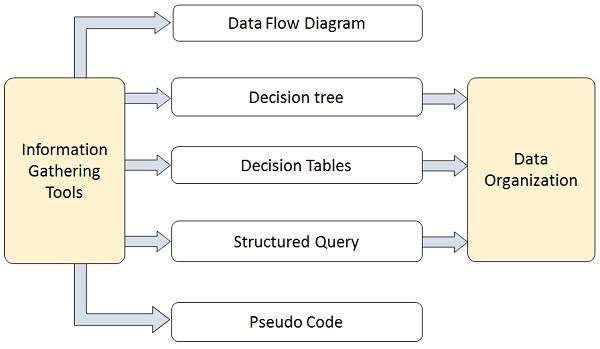
Data Flow Diagrams (DFD) or Bubble Chart
It is a technique developed by Larry Constantine to express the requirements of system in a graphical form.
It shows the flow of data between various functions of system and specifies how the current system is implemented.
It is an initial stage of design phase that functionally divides the requirement specifications down to the lowest level of detail.
Its graphical nature makes it a good communication tool between user and analyst or analyst and system designer.
It gives an overview of what data a system processes, what transformations are performed, what data are stored, what results are produced and where they flow.
Basic Elements of DFD
DFD is easy to understand and quite effective when the required design is not clear and the user wants a notational language for communication. However, it requires a large number of iterations for obtaining the most accurate and complete solution.
The following table shows the symbols used in designing a DFD and their significance −
Symbol Name Symbol Meaning Square 
Source or Destination of Data Arrow 
Data flow Circle 
Process transforming data flow Open Rectangle 
Data Store Types of DFD
DFDs are of two types: Physical DFD and Logical DFD. The following table lists the points that differentiate a physical DFD from a logical DFD.
Physical DFD Logical DFD It is implementation dependent. It shows which functions are performed. It is implementation independent. It focuses only on the flow of data between processes. It provides low level details of hardware, software, files, and people. It explains events of systems and data required by each event. It depicts how the current system operates and how a system will be implemented. It shows how business operates; not how the system can be implemented. Context Diagram
A context diagram helps in understanding the entire system by one DFD which gives the overview of a system. It starts with mentioning major processes with little details and then goes onto giving more details of the processes with the top-down approach.
The context diagram of mess management is shown below.
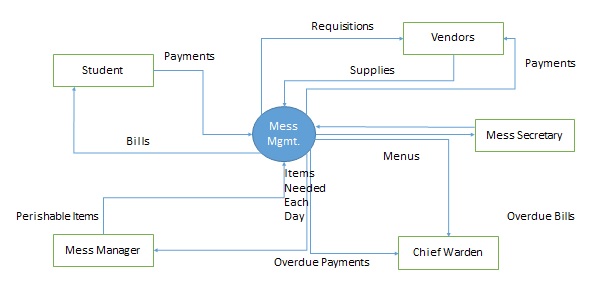
Data Dictionary
A data dictionary is a structured repository of data elements in the system. It stores the descriptions of all DFD data elements that is, details and definitions of data flows, data stores, data stored in data stores, and the processes.
A data dictionary improves the communication between the analyst and the user. It plays an important role in building a database. Most DBMSs have a data dictionary as a standard feature. For example, refer the following table −
Sr.No. Data Name Description No. of Characters 1 ISBN ISBN Number 10 2 TITLE title 60 3 SUB Book Subjects 80 4 ANAME Author Name 15 Decision Trees
Decision trees are a method for defining complex relationships by describing decisions and avoiding the problems in communication. A decision tree is a diagram that shows alternative actions and conditions within horizontal tree framework. Thus, it depicts which conditions to consider first, second, and so on.
Decision trees depict the relationship of each condition and their permissible actions. A square node indicates an action and a circle indicates a condition. It forces analysts to consider the sequence of decisions and identifies the actual decision that must be made.
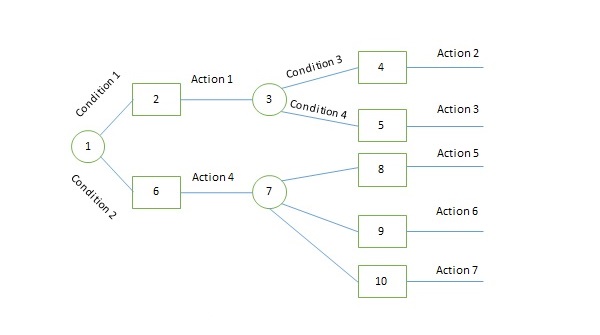
The major limitation of a decision tree is that it lacks information in its format to describe what other combinations of conditions you can take for testing. It is a single representation of the relationships between conditions and actions.
For example, refer the following decision tree −

Decision Tables
Decision tables are a method of describing the complex logical relationship in a precise manner which is easily understandable.
It is useful in situations where the resulting actions depend on the occurrence of one or several combinations of independent conditions.
It is a matrix containing row or columns for defining a problem and the actions.
Components of a Decision Table
Condition Stub − It is in the upper left quadrant which lists all the condition to be checked.
Action Stub − It is in the lower left quadrant which outlines all the action to be carried out to meet such condition.
Condition Entry − It is in upper right quadrant which provides answers to questions asked in condition stub quadrant.
Action Entry − It is in lower right quadrant which indicates the appropriate action resulting from the answers to the conditions in the condition entry quadrant.
The entries in decision table are given by Decision Rules which define the relationships between combinations of conditions and courses of action. In rules section,
- Y shows the existence of a condition.
- N represents the condition, which is not satisfied.
- A blank - against action states it is to be ignored.
- X (or a check mark will do) against action states it is to be carried out.
For example, refer the following table −
CONDITIONS Rule 1 Rule 2 Rule 3 Rule 4 Advance payment made Y N N N Purchase amount = Rs 10,000/- - Y Y N Regular Customer - Y N - ACTIONS Give 5% discount X X - - Give no discount - - X X Structured English
Structure English is derived from structured programming language which gives more understandable and precise description of process. It is based on procedural logic that uses construction and imperative sentences designed to perform operation for action.
It is best used when sequences and loops in a program must be considered and the problem needs sequences of actions with decisions.
It does not have strict syntax rule. It expresses all logic in terms of sequential decision structures and iterations.
For example, see the following sequence of actions −
if customer pays advance then Give 5% Discount else if purchase amount >=10,000 then if the customer is a regular customer then Give 5% Discount else No Discount end if else No Discount end if end if
Pseudocode
A pseudocode does not conform to any programming language and expresses logic in plain English.
It may specify the physical programming logic without actual coding during and after the physical design.
It is used in conjunction with structured programming.
It replaces the flowcharts of a program.
Guidelines for Selecting Appropriate Tools
Use the following guidelines for selecting the most appropriate tool that would suit your requirements −
Use DFD at high or low level analysis for providing good system documentations.
Use data dictionary to simplify the structure for meeting the data requirement of the system.
Use structured English if there are many loops and actions are complex.
Use decision tables when there are a large number of conditions to check and logic is complex.
Use decision trees when sequencing of conditions is important and if there are few conditions to be tested.
very useful sir
ReplyDelete